The Australian Mango Industry Association says its catchphrase "Love at first sight, Delight at first bite" has been a major factor behind the massive growth of the fruit over the past five years.
Three growth trends showed major increases from 2013 to 2018, where volume units grew by 42.2 per cent on the domestic market and average price also grew by 7.8 per cent, which translated to a 53.3 per cent rise in value (number of mangoes sold multiplied by the price). AMIA Marketing Manager Treena Welch told the 2019 Mango Conference in Darwin that was exciting given the combined total value growth of other fruit competitors was 26 per cent.
"Three things that bring to life Australian mangoes; they are full of emotion, they define our summer and they are the king of fruits - plus they are an Australian icon," Ms Welch said. "What has driven these growth trends is our collective plan; the plan that everyone in the industry is collaborating on to deliver every year."
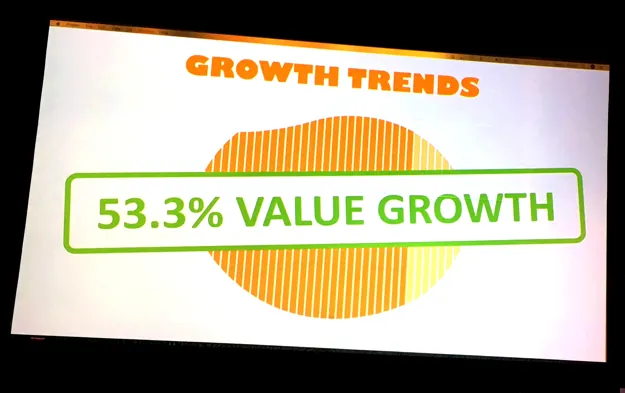
Ms Welch added that it was important to have an understanding of the consumer, and there are only "two moments of truth" which they value when making purchasing decisions.
"That's really unfortunate for all of us getting up at the crack of dawn, deciding what the next chemical is going to be, what temperature should the fruit be at, how the store is going to operate, how am I going to do my head office launch etc," she said. "These things mean zilch to the consumer. They only worry about two things. The first is what the fruit looks like; the consumers are attracted by big bold displays, but what is inside those displays is most important. The mango must look full, plump, vibrant and fresh. The second moment of truth is when they eat the mango; the consumer has a high expectation of that moment. They're expecting it to be juicy, sweet and packed with our unique mango flavour. If we deliver on that, it will drive repeat purchases."
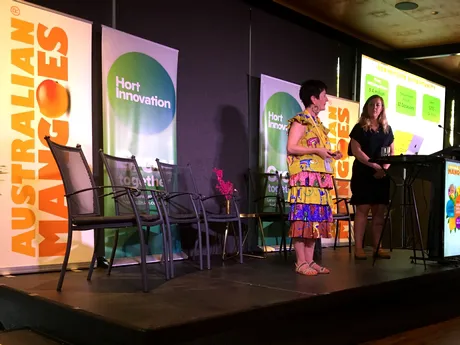
Photo:Treena Welch & Tate Connolly presenting at Australian Mango Conference
The number of times people are buying mangoes increased 27.5 per cent on last season from the previous year. However, there was also an increase in "lapsed buyers"; in 2017 5.5 million households purchased mangoes, but in 2018 only 4.3 million stayed with the category - 22 per cent or 1.2 million households left the category. Ms Welch says that provides a major opportunity to reverse this figure.
"Lapsed buyers are all about that moment of truth, and impulse is key" she said. "So, we had these large luscious displays that pulled people right in, they came to the front of the store but they chose to buy something else, rather than a mango. Quality is key, as 80 per cent of consumers say they make their decision about the quality of fruit that is on display. That's not just the price, but the value. So, there is a conversion opportunity here and we need focus on the 'first moment of truth' by everyone in the supply chain, to improve the appearance of fruit on display."
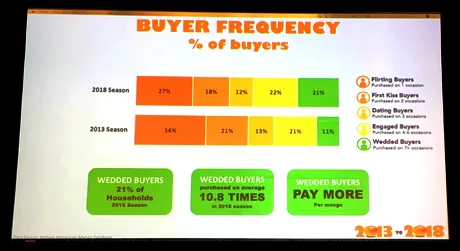
She went onto explain that last season, across the mango season time frame, 9.4 million Australian households (98.5 per cent) bought fruit, 5.1 million households purchased mangoes, and in that period those households bought fruit 32 times and mangoes four times.
"Our greatest branding, our greatest billboard and our greatest advertisement is that point of purchase display," Ms Welch said. "It isn't expensive, but it comes at a cost. We have to put fruit on there that looks good. So, what if we just looked at occasions, and said if we changed that penetration to 60 per cent (52 per cent in 2018), which would be 620.000 more households and will be more than 1 million mango trays. If we chose to increase mango buying occasions to five, that is 3.7 million occasions that a mango will be purchased. That opportunity is 1.4 million more mango trays. However, if we wanted to be big and bold and to go after both those metrics; 60 per cent of households and five occasions - that would equal 2.6 million more trays."
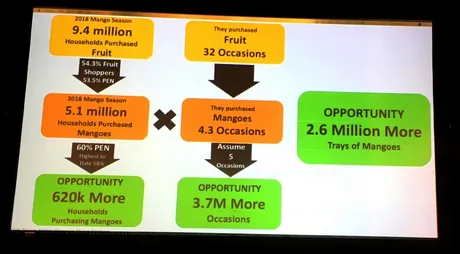
To help drive demand, Hort Innovation assisted the AMIA in several marketing campaigns throughout the 2018-19 season, including "#200daysofmangoes" on social media, and the "Mango Mess-tival!" event on Sydney's iconic Bondi Beach, in addition to a daily press office which supplied a range of media outlets with regular mango-related stories.
"We also put focus on key dates such as back to school and Valentine's Day, which kept them topical throughout the season," Hort Innovation Marketing Speciallist, Tate Connolly said. "Through that approach, what it meant was that we saw an increase in the number of people we were reaching from beginning to end. We saw a 3 per cent increase in pieces of coverage, with a focus on TV, and that increased the number of people we were reaching by 1,923 per cent."
But Ms Connolly pointed out that digitally is where a lot of consumer interaction takes place, especially for young people.
"There are 15 million Australians on Facebook and 9 million on Instagram - so that's why it forms such an important part of our strategy," she said. "On Facebook, this season, we saw an 18 per cent increase in the amount of people we reached, from last year - that gave a total of 3.35 million consumers. But it's not just our own channel (Australian Mangoes) that we try and communicate through, but we work with a group of influencers - who are people who have 1,000 followers or more, right up to 1-2 million on Facebook or Instagram. This year we had 44 per cent more photos and videos through these influencers."
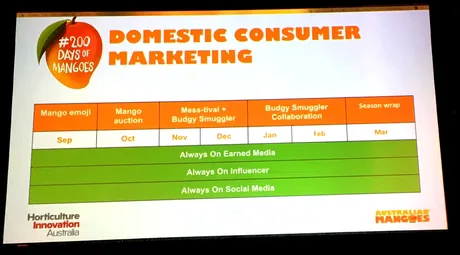
Engagement is another important factor in growth, according to Ms Welch, with the AMIA joining the country's major retailers to create a 'joint action plan', which is basically a calendar of events that celebrate the fruit at every available opportunity, such as Christmas, Australia Day, Halloween and even football grand finals.
Ms Welch says that the size and position of the display matters, as does additional promotional material such as point of sale and outside store signage, in addition to educating sales staff to have engaging and informative conversations with consumers. Growers also took part in tours of retail outlets during the season, and there were several sales competitions encouraging retailers to come up with creative ways to sell more fruit.
"It's a whole of season strategy - mangoes demand the attention of consumers and take centre stage for the whole of summer," she said. "This is the position we have to earn the right to have, every year. We've gone from a period where we used to have (major retail attention) from the start of summer until Christmas, and then it was only when we were on catalogue. Over the last three years, across all the retail outlets, we've managed to hold that front retail stage for the entire summer (October to March)."
